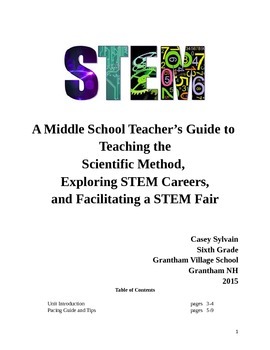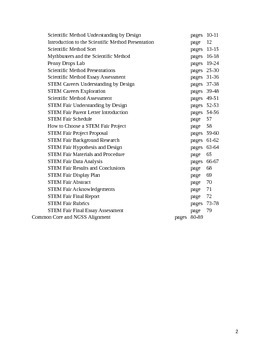Middle School/Upper Elementary Scientific Method and STEM Fair Unit
Casey Sylvain
9 Followers
Grade Levels
4th - 11th
Subjects
Resource Type
Standards
CCSS6.SP.A.1
CCSS6.SP.A.2
CCSS6.SP.A.3
CCSS6.SP.B.4
CCSS6.SP.B.5
Formats Included
- Word Document File
Pages
89 pages
Casey Sylvain
9 Followers
What educators are saying
I USED THIS WITH ALL MY CLASSES THEY LOVED IT AND IT KEPT THEM BUSY I WILL BE USING IT THIS YEAR ALSO
Description
This unit was designed as a way to incorporate STEM into a more traditional Science Fair model with connections to STEM careers. Students are encouraged to choose a topic that they are deeply interested in and they learn how to connect scientific thinking to concepts outside of science class. They are also introduced to future STEM careers and community resources. The unit is directly aligned to Next Generation Science Standards (NGSS) and the Common Core.
In order to help students achieve their best work, following is a list of suggested activities, teaching points, and resources to cover before, during, and after the STEM Fair unit. Initially, students are taught about the scientific method and complete activities to internalize the fluidity of the steps of the method. I teach this at the very beginning of the school year and revisit it throughout the year. After working on the scientific method and learning more about STEM as a concept, students delve into learning about STEM as a career path. Finally, students complete the STEM Fair later in the school year. Students conclude the unit with a final essay assessment of their own learning, their level of understanding, and address their work engagement.
I assign the STEM Fair in mid-January and begin discussing it with students. Students complete one assignment every week or two, turn it in via Google Classroom, and then culminate in a STEM Fair in late April. By spreading out the assignments and the work, we are able to continue our other work in science class while completing the STEM Fair work concurrently. As a wrap-up for the STEM Fair, students assess their own work, understanding, and areas of necessary growth.
At the end of the packet is final information regarding how to conclude the unit and wrap-up students’ presentations.
In order to help students achieve their best work, following is a list of suggested activities, teaching points, and resources to cover before, during, and after the STEM Fair unit. Initially, students are taught about the scientific method and complete activities to internalize the fluidity of the steps of the method. I teach this at the very beginning of the school year and revisit it throughout the year. After working on the scientific method and learning more about STEM as a concept, students delve into learning about STEM as a career path. Finally, students complete the STEM Fair later in the school year. Students conclude the unit with a final essay assessment of their own learning, their level of understanding, and address their work engagement.
I assign the STEM Fair in mid-January and begin discussing it with students. Students complete one assignment every week or two, turn it in via Google Classroom, and then culminate in a STEM Fair in late April. By spreading out the assignments and the work, we are able to continue our other work in science class while completing the STEM Fair work concurrently. As a wrap-up for the STEM Fair, students assess their own work, understanding, and areas of necessary growth.
At the end of the packet is final information regarding how to conclude the unit and wrap-up students’ presentations.
Total Pages
89 pages
Answer Key
Included with rubric
Teaching Duration
1 Semester
Report this resource to TPT
Reported resources will be reviewed by our team. Report this resource to let us know if this resource violates TPT’s content guidelines.
Standards
to see state-specific standards (only available in the US).
CCSS6.SP.A.1
Recognize a statistical question as one that anticipates variability in the data related to the question and accounts for it in the answers. For example, “How old am I?” is not a statistical question, but “How old are the students in my school?” is a statistical question because one anticipates variability in students’ ages.
CCSS6.SP.A.2
Understand that a set of data collected to answer a statistical question has a distribution which can be described by its center, spread, and overall shape.
CCSS6.SP.A.3
Recognize that a measure of center for a numerical data set summarizes all of its values with a single number, while a measure of variation describes how its values vary with a single number.
CCSS6.SP.B.4
Display numerical data in plots on a number line, including dot plots, histograms, and box plots.
CCSS6.SP.B.5
Summarize numerical data sets in relation to their context, such as by:





